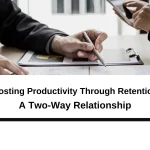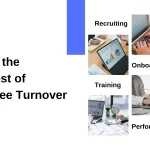
Saving money for your company requires reducing employee turnover costs. A high turnover rate destroys resources and slows growth. By focusing on retention strategies, companies can significantly lower these costs and increase the longevity of their best employees.
Keeping employees is one of the most difficult problems that businesses are currently facing. Maintaining the happiness and motivation of talented employees not only saves money but also speeds up company development. Work flows better, teams are stronger, and consumers receive better service when employees remain longer. Every firm must therefore comprehend how to measure and enhance retention.
Leaders may get a clear understanding of why employees stay or depart by monitoring the appropriate employee retention indicators. Businesses can identify issues and make better decisions to retain their top employees by keeping an eye on these figures. This article will go over the most important metrics that any HR director should closely monitor in order to improve employee retention and create a more loyal, satisfied workforce.
Turnover costs are more than just the expense of hiring someone new. They include lost productivity, extra workload on remaining staff, and the time it takes for a new hire to fully settle in. Over time, these hidden costs can quietly drain your business resources and slow growth.
When you lose staff, it affects your entire company, not simply the desks that remain empty. Every departure has a cost, ranging from the reduced team morale and productivity to the expense of hiring and training new employees. These setbacks frequently accumulate more quickly than most organizations anticipate, impacting your bottom line more severely than anticipated.
Cutting corners isn’t always the only way to save money. Actually, the best way to lower personnel turnover costs is to concentrate on tactics that boost team morale while preserving or even raising the caliber of your work.
Make modest yet significant changes first:
These actions don’t require massive budgets, but they do require consistency. When employees feel supported, respected, and heard, they’re more likely to stay, and that means lower hiring and training costs for you without any drop in the quality of work delivered.
Turnover costs go beyond job ads and interviews. Lost knowledge, extra stress on your team, and delays in projects are hidden expenses that quietly eat into your profits.
To know the real impact, add up recruitment, training, lost productivity, and any mistakes made during the adjustment period. You’ll quickly see that losing a good employee is more expensive than you thought.
Maintaining a solid team culture, trust, and stability are more important factors in employee retention than cost reduction. Valued employees perform better, remain with you longer and contribute to the expansion of your company.
Hiring and training are direct expenditures, but lost knowledge, low morale, and decreased productivity are hidden costs. If turnover is high, both soon add up.
Happy employees work better, stay loyal, and get more done. If you take care of your team from the start. You can save your company a lot of money and avoid the high costs of replacing them.
A good company culture helps employees feel connected and happy. When workers like their workplace, they stay longer, which lowers employee turnover cost.
If the culture is bad, people leave quickly. This raises the cost of hiring and training new employees. Building a strong culture is key to reducing turnover costs.
When employees feel appreciated, they work better and stay longer. Recognition programs show that their efforts matter, which helps lower employee turnover cost.
Praising good work makes people want to stay with the company. This reduces the need to hire and train new staff, saving money and time.
One of the best ways to save money in 2025 is to keep your employees. Focus on your best workers to build a stronger team. This helps you avoid the high costs of turnover.
When businesses work to reduce turnover. They save money and boost productivity. It also improves employee morale.
Let’s talk about how OpenElevator can help you solve it. Contact Us now.

Boosting Productivity Through Retention: A Two-Way Relationship Minal Joshi Jaeckli October 31, 2025 When leaders talk about productivity, the conversation almost always drifts toward tools,.

What Is the Real Cost of Employee Turnover? (And How to Reduce It) Minal Joshi Jaeckli October 28, 2025 Every leader knows turnover is costly,.

How Workplace Flexibility Boosts Employee Satisfaction and Reduces Turnover Minal Joshi Jaeckli October 25, 2025 Work has changed a lot in the past few years..